
Secotioid fungi produce an intermediate fruiting body form that is between the mushroom-like hymenomycetes and the closed bag-shaped gasteromycetes, where an evolutionary process of gasteromycetation has started but not run to completion. Secotioid fungi may or may not have opening caps, but in any case they often lack the vertical geotropic orientation of the hymenophore needed to allow the spores to be dispersed by wind, and the basidiospores are not forcibly discharged or otherwise prevented from being dispersed —note—some mycologists do not consider a species to be secotioid unless it has lost ballistospory.

Clitocybe is a genus of mushrooms characterized by white, off-white, buff, cream, pink, or light-yellow spores, gills running down the stem, and pale white to brown or lilac coloration. They are primarily saprotrophic, decomposing forest ground litter. There are estimated to be around 300 species in the widespread genus.

Collybia nuda, commonly known as the blewit or wood blewit and previously described as Lepista nuda and Clitocybe nuda, is an edible mushroom native to Europe and North America. Described by Pierre Bulliard in 1790, it was also known as Tricholoma nudum for many years. It is found in both coniferous and deciduous woodlands. It is a fairly distinctive mushroom that is widely eaten. It has been cultivated in Britain, the Netherlands and France. This species was reassigned to the genus Collybia in 2023.

Entoloma sinuatum is a poisonous mushroom found across Europe and North America. Some guidebooks refer to it by its older scientific names of Entoloma lividum or Rhodophyllus sinuatus. The largest mushroom of the genus of pink-spored fungi known as Entoloma, it is also the type species. Appearing in late summer and autumn, fruit bodies are found in deciduous woodlands on clay or chalky soils, or nearby parklands, sometimes in the form of fairy rings. Solid in shape, they resemble members of the genus Tricholoma. The ivory to light grey-brown cap is up to 20 cm (7.9 in) across with a margin that is rolled inward. The sinuate gills are pale and often yellowish, becoming pink as the spores develop. The thick whitish stem has no ring.

Collybia personata is a species of edible fungus commonly found growing in grassy areas across Europe and is morphologically related to the wood blewit Collybia nuda. This mushroom was moved to the genus Collybia in 2023.

Clitocybe nebularis or Lepista nebularis, commonly known as the clouded agaric, cloudy clitocybe, or cloud funnel, is an abundant gilled fungus which appears both in conifer-dominated forests and broad-leaved woodland in Europe and North America. Appearing in Britain from mid to late autumn, it is edible, but may cause gastrointestinal issues.

Paralepistopsis acromelalga is a basidiomycete fungus in the Tricholomataceae family. It was formerly classified as Clitocybeacromelalga.
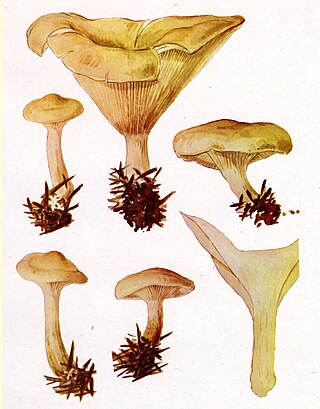
Paralepistopsis amoenolens is an agaric fungus in the Tricholomataceae family. It is commonly known as the paralysis funnel.
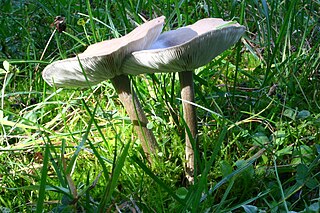
Melanoleuca is a poorly known genus of saprotrophic mushrooms traditionally classified in the family Tricholomataceae. Most are small to medium sized, white, brown, ocher or gray with a cylindrical to subcylindrical stipe and white to pale yellowish gills. The basidiospores are ellipsoid and ornamented with amyloid warts. Melanoleuca is considered a difficult group to study due to their macroscopic similarities among species and the need of a thorough microscopic analysis to separate species. DNA studies have determined that this genus is closely related to Amanita and Pluteus and that it does not belong to the family Tricholomataceae.

Aspropaxillus giganteus, formerly Leucopaxillus giganteus, commonly known as the giant leucopax or the giant funnel, is a saprobic species of fungus in the order Agaricales. As its common names imply, the fruit body, or mushroom, can become quite large—the cap reaches diameters of up to 50 cm (20 in). It has a white or pale cream cap, and is funnel-shaped when mature, with the gills running down the length of the stem. Considered by some to be a choice edible when young, this species has a cosmopolitan distribution, and is typically found growing in groups or rings in grassy pastures, roadside hedges, or woodland clearings. It has been shown to contain a bioactive compound with antibiotic properties.

Infundibulicybe is a genus of fungi that is robustly placed incertae sedis as sister group to the Tricholomatoid clade. It has previously been part of the family of Tricholomataceae, but recent molecular phylogeny has shown it to take an isolated position within the Agaricales.

Clitocybula is a genus of mushroom-forming fungi in the family Porotheleaceae but was originally classified within Marasmiaceae. The genus was circumscribed by Georges Métrod in 1952. Species in the genus are commonly known as "coincaps".
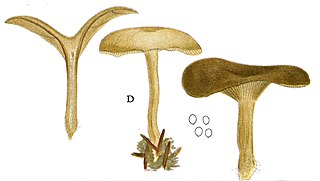
Clitocybe brumalis, commonly known as the winter funnel cap, brumalis signifying "wintry", is an inedible mushroom of the genus Clitocybe. It grows in deciduous and coniferous woodland, only in winter; sometimes even under snow.

Paralepista flaccida is a species of mushroom found across the Northern Hemisphere. It is known to form fairy rings.
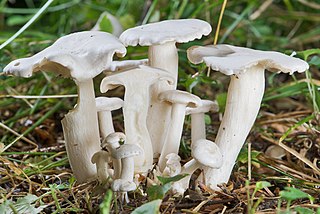
Leucocybe is a recently defined mushroom genus in the family Tricholomataceae. The species resemble Clitocybe and grow in forests or disturbed areas.
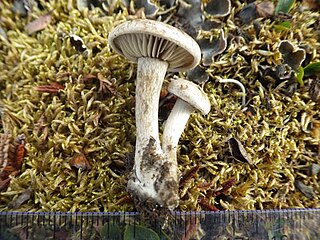
Atractosporocybe is a mushroom genus in the family Tricholomataceae in the broad sense. The type species resembles Clitocybe and grows in forests.

Clitocybe amarescens is a species of agaric fungus in the family Tricholomataceae. Widely distributed in northwestern Europe, it was first described in 1969 by Finnish mycologist Harri Harmaja. It fruits in groups or in fairy rings in grasslands. Amarescens signifies "tending to bitterness".

Infundibulicybe gibba, and commonly known as the common funnel or funnel cap, is a species of gilled mushroom which is common in European woods.
Paralepistopsis is a genus of fungi in the family Tricholomataceae.

Collybia phyllophila, commonly known as the frosty funnel or the leaf-loving clitocybe, is a fungus in the family Tricholomataceae. Its epithet, meaning leaf-loving comes from its preference for leaf litter. It is common among forests in the Northern Hemisphere, and is poisonous.




















